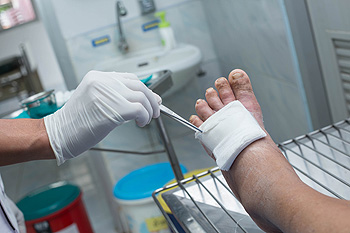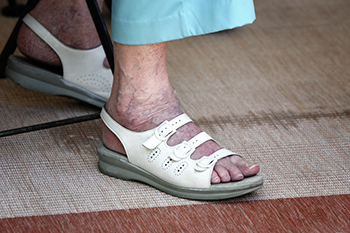Connect With Us
Blog
Items filtered by date: December 2023
Diagnosing an Achilles Tendon Rupture

An Achilles tendon rupture often presents suddenly, typically accompanied by a sharp pain in the back of the leg and sometimes an audible snapping sound. Many people with this injury mistakenly believe they have been hit in the calf. When examining for an Achilles rupture, the presence of swelling and bruising varies and is not entirely reliable. The gap in the tendon that indicates a rupture is often not easily palpable due to local swelling. In terms of mobility, patients can usually still perform some active movement in the ankle because other tendons also connect the calf to the foot. Pain affects passive movement but does not always limit it. Despite a ruptured Achilles, those affected can often still walk and may even be able to stand on tiptoes when using both feet, though not on the injured limb alone. The Simmonds' calf squeeze test is a reliable way for podiatrists to check for an Achilles tendon rupture. The test is done by having the patient kneel or lie prone with dangling feet. The healthy calf is used to see the foot flex, while no movement on the injured side indicates a ruptured Achilles tendon. If you believe you may have injured your Achilles tendon, it is strongly suggested that you make an appointment with a podiatrist for a thorough evaluation, diagnosis, and appropriate treatment.
Achilles tendon injuries need immediate attention to avoid future complications. If you have any concerns, contact Paul Hutchison, DPM of Hutchison Foot Clinic. Our doctor can provide the care you need to keep you pain-free and on your feet.
What Is the Achilles Tendon?
The Achilles tendon is a tendon that connects the lower leg muscles and calf to the heel of the foot. It is the strongest tendon in the human body and is essential for making movement possible. Because this tendon is such an integral part of the body, any injuries to it can create immense difficulties and should immediately be presented to a doctor.
What Are the Symptoms of an Achilles Tendon Injury?
There are various types of injuries that can affect the Achilles tendon. The two most common injuries are Achilles tendinitis and ruptures of the tendon.
Achilles Tendinitis Symptoms
- Inflammation
- Dull to severe pain
- Increased blood flow to the tendon
- Thickening of the tendon
Rupture Symptoms
- Extreme pain and swelling in the foot
- Total immobility
Treatment and Prevention
Achilles tendon injuries are diagnosed by a thorough physical evaluation, which can include an MRI. Treatment involves rest, physical therapy, and in some cases, surgery. However, various preventative measures can be taken to avoid these injuries, such as:
- Thorough stretching of the tendon before and after exercise
- Strengthening exercises like calf raises, squats, leg curls, leg extensions, leg raises, lunges, and leg presses
If you have any questions please feel free to contact our office located in Memphis, TN . We offer the newest diagnostic tools and technology to treat your foot and ankle needs.
Diabetic Foot Ulcers

The main cause of foot ulcers in diabetic patients is often minor injuries happening when they cannot feel their feet properly. This happens due to a condition called peripheral sensory neuropathy. In simpler terms, it means their nerves do not work well, making them less sensitive to pain or injuries. Along with this, deformities in the foot shape and occasional trauma can play a role in causing foot ulcers. Additional factors in foot ulcer formation include calluses, swelling, and problems with blood circulation to the lower legs and feet. Neuropathy seems to involve various chemical processes and high blood sugar levels. Controlling blood sugar is vital in preventing neuropathy and foot ulcers. If you have diabetes and are experiencing foot ulcers, it is strongly suggested that you visit a podiatrist for immediate care.
Wound care is an important part in dealing with diabetes. If you have diabetes and a foot wound or would like more information about wound care for diabetics, consult with Paul Hutchison, DPM from Hutchison Foot Clinic. Our doctor will assess your condition and provide you with quality foot and ankle treatment.
What Is Wound Care?
Wound care is the practice of taking proper care of a wound. This can range from the smallest to the largest of wounds. While everyone can benefit from proper wound care, it is much more important for diabetics. Diabetics often suffer from poor blood circulation which causes wounds to heal much slower than they would in a non-diabetic.
What Is the Importance of Wound Care?
While it may not seem apparent with small ulcers on the foot, for diabetics, any size ulcer can become infected. Diabetics often also suffer from neuropathy, or nerve loss. This means they might not even feel when they have an ulcer on their foot. If the wound becomes severely infected, amputation may be necessary. Therefore, it is of the upmost importance to properly care for any and all foot wounds.
How to Care for Wounds
The best way to care for foot wounds is to prevent them. For diabetics, this means daily inspections of the feet for any signs of abnormalities or ulcers. It is also recommended to see a podiatrist several times a year for a foot inspection. If you do have an ulcer, run the wound under water to clear dirt from the wound; then apply antibiotic ointment to the wound and cover with a bandage. Bandages should be changed daily and keeping pressure off the wound is smart. It is advised to see a podiatrist, who can keep an eye on it.
If you have any questions, please feel free to contact our office located in Memphis, TN . We offer the newest diagnostic and treatment technologies for all your foot care needs.
Causes and Risk Factors of Foot Stress Fractures

Foot stress fractures, tiny cracks in the bones, can emerge from a myriad of factors that subject the feet to repetitive stress and strain. One primary cause is overuse, where excessive or sudden increases in physical activity like running or prolonged standing surpass the bones' capacity for repair. Wearing inadequate footwear or worn-out shoes lacking proper support amplifies the risk, as they fail to absorb shock adequately. Biomechanical factors, like abnormal foot structure or gait patterns, contribute to uneven weight distribution, placing specific areas under heightened stress. Insufficient conditioning and muscle fatigue diminish the ability of muscles to absorb impact, transferring excess force to the bones. Additionally, nutritional deficiencies, particularly in calcium and vitamin D, compromise bone strength, elevating the susceptibility to stress fractures. By wearing proper footwear, adopting a gradual training progression, and supplying nutritional support, individuals can fortify their foot health and reduce the likelihood of encountering the discomfort associated with stress fractures. If you have developed a foot stress fracture, it is suggested that you are under the care of a podiatrist who can offer you the treatment option that is right for you.
Activities where too much pressure is put on the feet can cause stress fractures. To learn more, contact Paul Hutchison, DPM from Hutchison Foot Clinic. Our doctor can provide the care you need to keep your pain free and on your feet.
Dealing with Stress Fractures of the Foot and Ankle
Stress fractures occur in the foot and ankle when muscles in these areas weaken from too much or too little use. The feet and ankles then lose support when walking or running from the impact of the ground. Since there is no protection, the bones receive the full impact of each step. Stress on the feet can cause cracks to form in the bones, thus creating stress fractures.
What Are Stress Fractures?
Stress fractures occur frequently in individuals whose daily activities cause great impact on the feet and ankles. Stress factors are most common among:
- Runners
- People affected with Osteoporosis
- Tennis or basketball players
- Gymnasts
- High impact workouts
Symptoms
Pain from the fractures occur in the area of the fractures and can be constant or intermittent. It will often cause sharp or dull pain with swelling and tenderness. Engaging in any kind of activity which involves high impact will aggravate pain.
If you have any questions please feel free to contact our office located in Memphis, TN . We offer the newest diagnostic and treatment technologies for all your foot and ankle needs.
Ankle Fracture? Don’t Wait for Treatment
Aging and Biomechanics of the Feet

Foot pain is a common issue among the elderly, and it can make it harder for them to move around and enjoy life. Scientists have been studying the connection between how our feet work as a link of foot problems in older people. They found that as we get older, our feet tend to get stiffer, have less movement, and become weaker. Our feet also tend to tilt inward which can make walking less efficient and cause foot pain. All these changes can make it difficult to perform everyday activities that involve standing or walking. Additionally, It can increase the chance of falling. If you have foot pain and are older or taking care of someone who is elderly, it is suggested that you make an appointment with a podiatrist for an examination which can determine the cause of existing foot conditions, and correct treatment to make movement more comfortable.
If you have any concerns about your feet, contact Paul Hutchison, DPM from Hutchison Foot Clinic. Our doctor can provide the care you need to keep you pain-free and on your feet.
Biomechanics in Podiatry
Podiatric biomechanics is a particular sector of specialty podiatry with licensed practitioners who are trained to diagnose and treat conditions affecting the foot, ankle and lower leg. Biomechanics deals with the forces that act against the body, causing an interference with the biological structures. It focuses on the movement of the ankle, the foot and the forces that interact with them.
A History of Biomechanics
- Biomechanics dates back to the BC era in Egypt where evidence of professional foot care has been recorded.
- In 1974, biomechanics gained a higher profile from the studies of Merton Root, who claimed that by changing or controlling the forces between the ankle and the foot, corrections or conditions could be implemented to gain strength and coordination in the area.
Modern technological improvements are based on past theories and therapeutic processes that provide a better understanding of podiatric concepts for biomechanics. Computers can provide accurate information about the forces and patterns of the feet and lower legs.
Understanding biomechanics of the feet can help improve and eliminate pain, stopping further stress to the foot.
If you have any questions please feel free to contact our office located in Memphis, TN . We offer the newest diagnostic and treatment technologies for all your foot and ankle needs.

